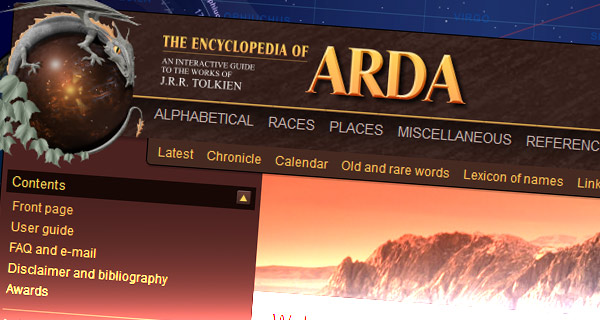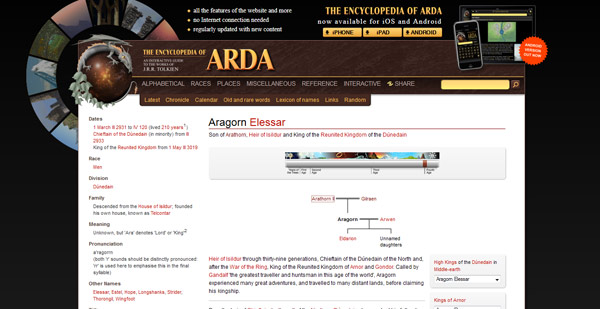The goings of Middle Earth have been occupying my thoughts as of late, what with The Hobbit: The Battle of the Five Armies hitting the box office last month.
SPOILERS, btw.
There’s a scene in which Galadriel attempts to rescue Gandalf from the clutches of the Necromancer/Sauron, only to get cornered by the Witch-King of Angmar and his Nazgul. She is then in turn aided by old bird-poop McCoy, Radagast the Brown and Elrond “Isildur, cast the ring into the fire!” of Rivendell. In that moment, I pondered. Hmm, is this the first time Elrond and Galadriel have appeared together on screen? I wonder if he’s gonna call her ‘Mother.’ Wait, or is it mother-in-law?
Either way, I made a mental note to myself, to check it on The Encyclopedia of Arda when I got home.
Encyclopedia of Arda? What the hell is that?
Well, it’s an online database with both wide and deep knowledge of the Tolkien-verse.
Cool, but why is it called the Encyclopedia of Arda? I thought The Lord of the Rings took place in Middle Earth?
Yes, that’s correct, the events chronicled in The Lord of the Rings take place in Middle Earth. But, unbeknownst to many, Middle Earth is only one region of a world called Arda. Much like Ansalon on Krynn, or Asia on IRL Earth. Hence: The Encyclopedia of Arda.
The Encyclopedia of Arda was created in 1997 by a man named Mark Fisher. Like a great many of websites back then, it was created as a tribute to a specific fandom, in this case, the works of J.R.R. Tolkien.
How’d I find out about it? Well, back in 1998 I was a whirling dervish of reading. I had always been a voracious reader, but playing D&D had turned me into a fanatic. Often, in the final section of TSR’s Complete Handbook series (e.g. The Complete Paladin’s Handbook or The Complete Psionicist’s Handbook), they would have a section called something to the effect of “Recommended Reading,” or “Examples of This Character in Literature,” where they would have a list of literary characters that you might want to check out to get a better idea of how to play a Knight Errant or a Wyrmslayer Paladin. Anyway, it was one of these sections at the end of the Complete Handbooks that turned me on to The Lord of the Rings. For teenage me, it was a bit of a slog, but I had just finished reading Ivanhoe by Sir Walter Scott, so more contemporary English was very welcomed. Once I found my flow with the books, I was hooked.

This brings me to UCI. Being the nerd I am, I would sometimes spend the day at my future alma mater – not to go to parties or look at all the cute college girls, really. I was there checking out the awesome library system, and more importantly, the internet connection. T1 broadband, it was like magic to me. I would spend hours on AltaVista or Infoseek, just searching stuff. “Ooh, I wonder if there’s a website about this,” was my mantra. Of course, I was on a current LOTR kick, so I typed that into the search field and voila, first result: The Encyclopedia of Arda.
“Why the hell is a site called The Encyclopedia of Arda the first result on a Lord of the Rings search?” I thought. I clicked on, and my young mind was blown. Tiny bits of figurative grey matter flung helter skelter on the book stacks behind me. The information on LOTR and more, it was all there, in its glorious depth and breadth, in a single neat website. It was like Encarta, but just about the works of Tolkien. It may have been the first website I ever bookmarked.
But, why is The Encyclopedia of Arda so cool?
Well, first off, it’s straight up old skool. It’s a LOTR wiki before WikiMedia was even a thing. It’s a relic from web 1.0 that managed to update its look and keep itself relevant for more than a decade – something you can check out via The Wayback Machine. That’s just snazzy.
Secondly, one feature I find particularly helpful are two images that show in every character entry. 1) A timeline showing their relevant/active timeframe (e.g. Gandalf’s active years were during the later half of the Third Age), and 2)A small pedigree chart, showing who begat who, or who was begotten.
For example, let’s take a look at the entry on Aragorn, King Elessar – whom many of you love from the movies. My, what’s that, oh it’s a timeline and a pedigree, just as I mentioned. So, Aragorn’s life bridged the Third and Fourth ages, and he was the son of Arathorn II and a ranger named Gilraen. And in the leftmost column, what to do we have there? Looks like more information, like race, dates of birth and death, and ooh, a pronunciation key. Magnificent. Yeah, it’s a tad nerdy, I can’t help it.
I mean, even the footnotes section is fascinating, because Fisher goes into detail about some of the possible contentions and sources on the info presented. This was where I found about other Tolkien works/anthology of letters and such, which included books like Unfinished Tales, Lost Tales, and The Silmarillion.
It was through this site that I discovered just how deep what we now call worldbuilding went with Tolkien. From the creation stories, to the creation of languages, the etymologies of words, to the grand myriad of different types of creatures and entities, it’s all pretty darn mind-boggling. Ainur? Valar? Maiar? Eru Illuvatar? The list, it extends. The Encyclopedia of Arda, however, made everything much clearer, especially in an age of Wikipedia-less-ness.
Not saying you have to, but if you’re a Tolkien fan in any capacity, you should probably check it out. Android and iOS apps available, or so I hear.



